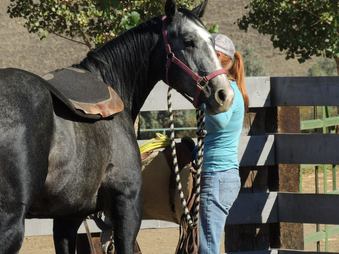Lameness Evaluation

Many of our doctor's appointments are focused on diagnosing the source of lameness in horses. Lameness can result from any number of sources, including muscle pain, joint disease, developmental bone abnormalities, conformational abnormalities, inflammation in tendons (tendonitis) and ligaments (desmitis) and bone injuries. With this spectrum of possibilities, a well trained doctor is a must at your horse's side. Our staff is well versed in discovering the source of your horses pain, and developing an appropriate treatment. While a brief exam may be pursued under certain circumstances, we often recommend a thorough, systematic approach to identify the cause of your horse's lameness.
A lameness evaluation routinely entails examining your horse for conformational abnormalities, palpating all pertinent musculoskeletal structures for pain, heat or swelling, and evaluating your horses gait under varying conditions and after joint flexion tests. This evaluation process directs our attention to the region and structures affected, which then allows us to determine which diagnostic tests we choose to perform. These may include nerve blocks (to regionalize the source of lameness) or ultrasound and radiographs, which help identify the specific causes of lameness.
Lameness often cannot be effectively treated without a specific diagnosis. While some sources of lameness, such as foot abscesses and hock arthritis (spavin), are common and more easily diagnosed, lameness resulting from soft tissue injuries can be subtle and manifest as poor performance or reluctance to perform specific movements. Here at SMVS, we strive to determine the exact source of your horses issue, which allows us to select the best possible course of therapy.
If you would like more information about general lameness exams, please visit the AAEP site HERE.
A lameness evaluation routinely entails examining your horse for conformational abnormalities, palpating all pertinent musculoskeletal structures for pain, heat or swelling, and evaluating your horses gait under varying conditions and after joint flexion tests. This evaluation process directs our attention to the region and structures affected, which then allows us to determine which diagnostic tests we choose to perform. These may include nerve blocks (to regionalize the source of lameness) or ultrasound and radiographs, which help identify the specific causes of lameness.
Lameness often cannot be effectively treated without a specific diagnosis. While some sources of lameness, such as foot abscesses and hock arthritis (spavin), are common and more easily diagnosed, lameness resulting from soft tissue injuries can be subtle and manifest as poor performance or reluctance to perform specific movements. Here at SMVS, we strive to determine the exact source of your horses issue, which allows us to select the best possible course of therapy.
If you would like more information about general lameness exams, please visit the AAEP site HERE.